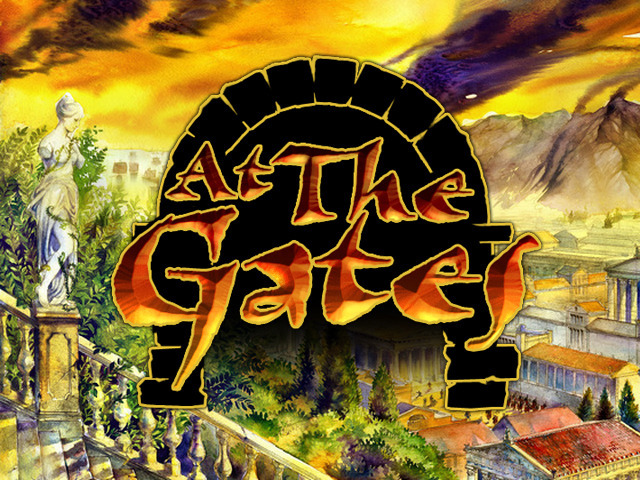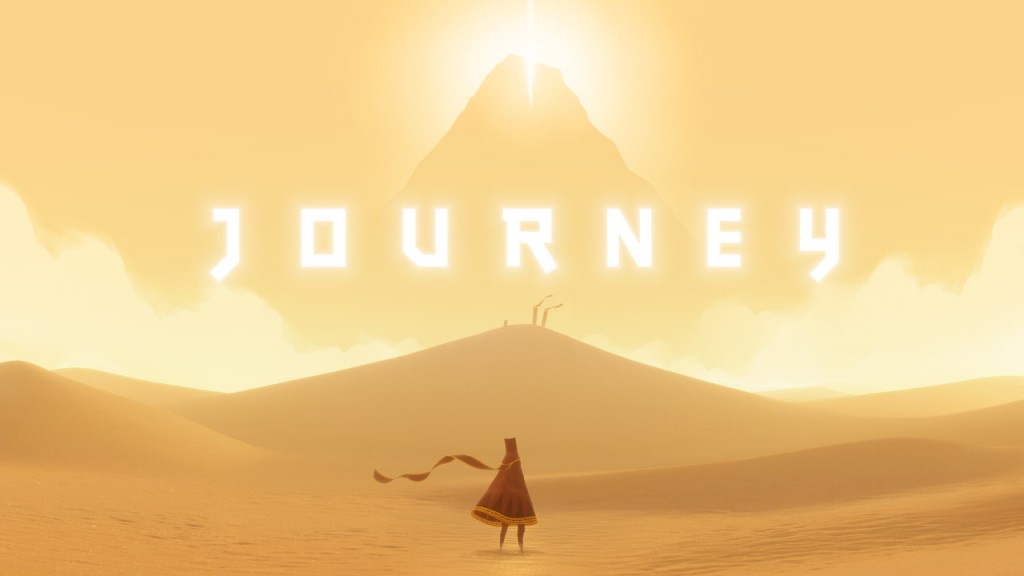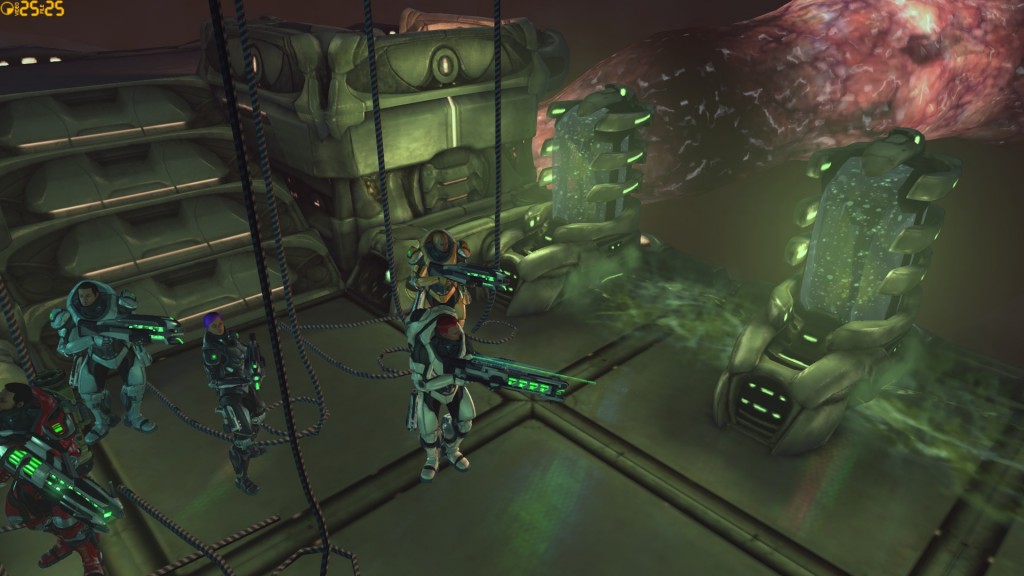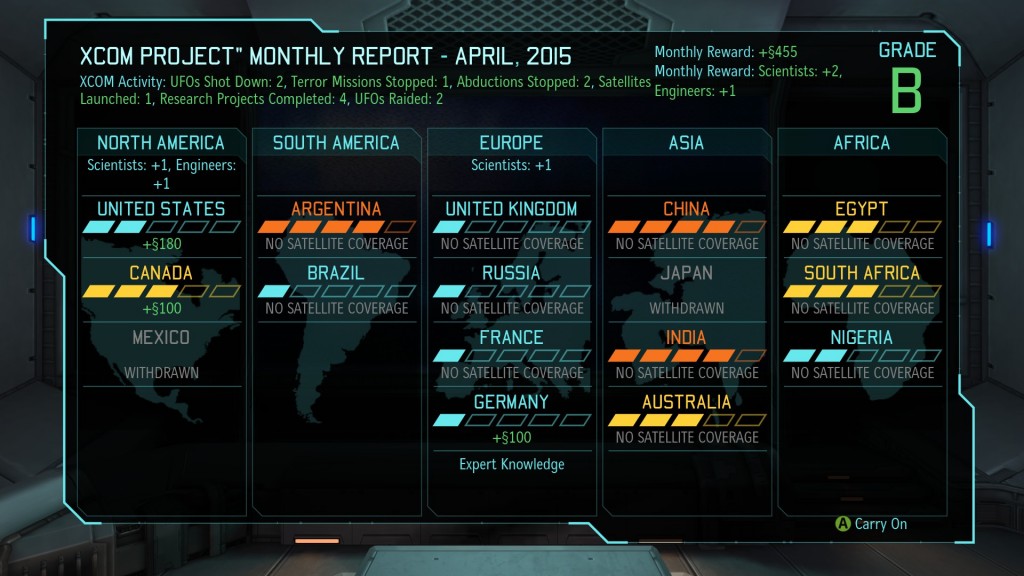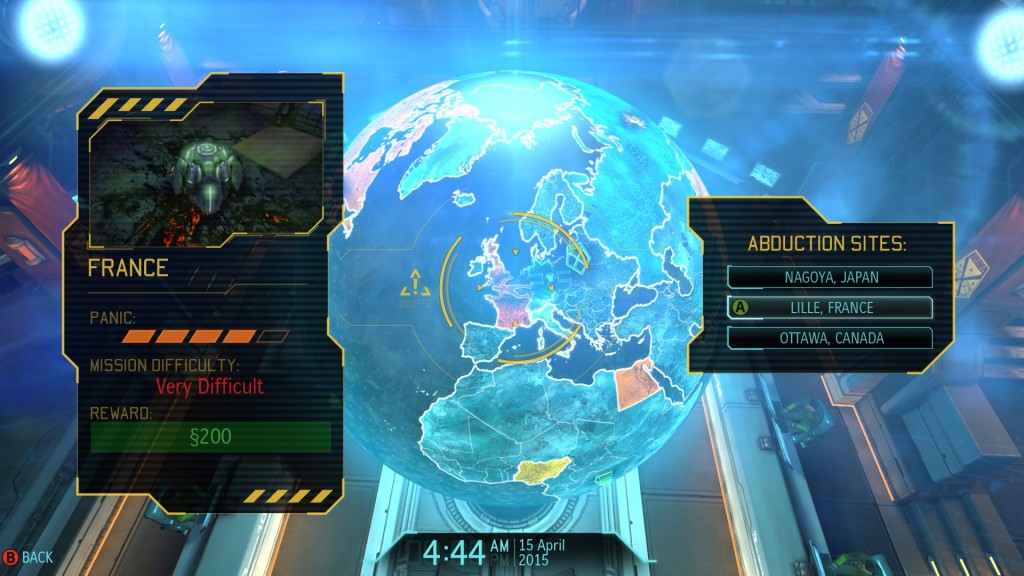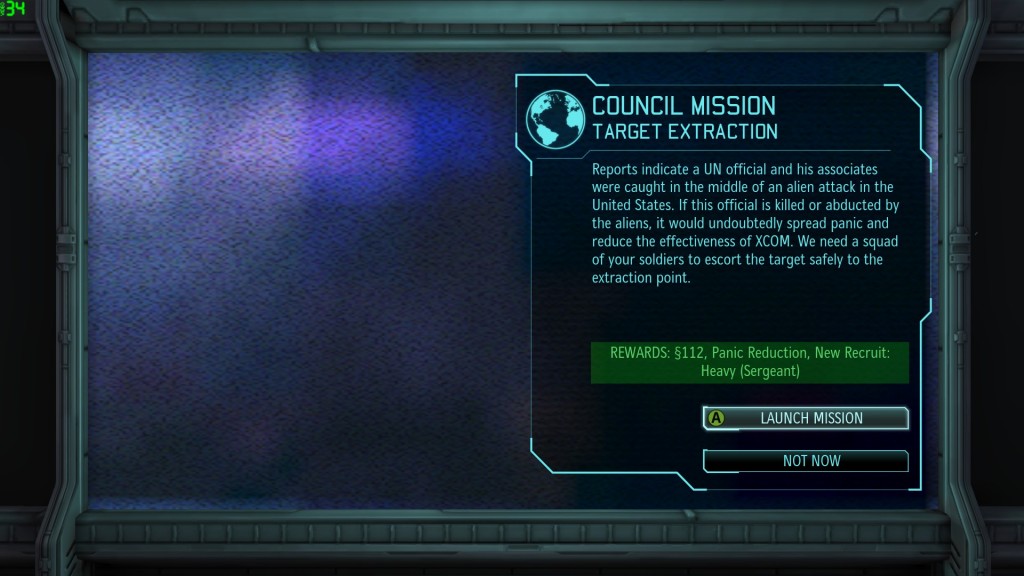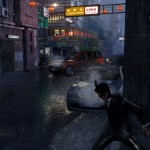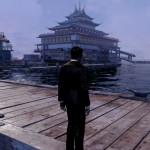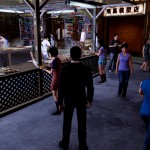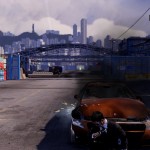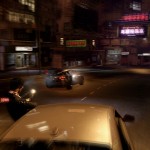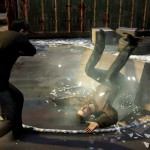That is the title of a short, but really interesting, Financial Times piece on virtual economics (free registration required). For years I’ve wanted to see the mainstream media pick up on the “giant social sciences lab” nature of games such as EVE Online, and now my wish has come true! Well worth a look if you’re interested in the subject.
Games
At the Gates Q&A with Jon Shafer!
Civilization V designer Jon Shafer has unveiled his latest project on Kickstarter: At the Gates, a 4X strategy game that casts the player as a barbarian chief out to pick the carcass of the crumbling Roman Empire. The game sets out to fix one of the biggest problems in strategy gaming, the boring middle/late game, and its promised features include:
1. An emphasis on supply: armies will have only a limited capacity to live off the land, making them reliant on supply trains and friendly cities;
2. A dynamic map: resources will deplete over time (placing players under greater and greater pressure as the game goes on); seasons will affect the map as rivers freeze and food stockpiles dwindle during winter;
3. Asymmetric non-player factions: the Romans are still on the map, play by different rules to the barbarians, and won’t give up without a fight.
This all sounded very interesting to me, and Jon was kind enough to sit down for an email interview. Read on:
Xenoblade Chronicles impressions: The Force is strong in this game
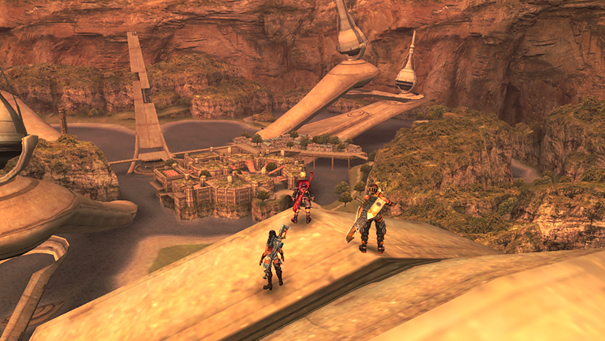
Of all the magic woven by storytellers, immersion has to be one of the most precious threads. How wonderful it is that we can pick up a book, or play a game, or sit in a cinema, and be transported into another world! The people who write bullet points for video game boxes know this, which is why “immersive” is one of their favourite buzzwords. So is “visceral”, which I find telling. To be immersive, it seems, a work should have us on the edge of our seats: tense, excited, ready to feel its characters’ pain as if it were our own. But there’s also another kind of immersion – think of the proverbial warm soak. An immersive world can be utterly relaxing, an invitation for us to kick back and lose ourselves for an hour or two. Nearly 20 hours into Xenoblade Chronicles, I can say it exemplifies the latter.
Xenoblade is an RPG for the Nintendo Wii – a platform exclusive, as a matter of fact. It’s a party-based JRPG that bears a striking similarity to 2006’s Final Fantasy XII, in that there are no random encounters and no distinction between an overworld, area maps, and combat screens. Rather, like a Western RPG, monsters are clearly visible – and combat takes place – in the field. Combat is real-time, and the player only controls one party member at a time, chosen before battle starts; the rest of the party is controlled by a generally competent AI. Since the chosen character will auto-attack enemies, the player’s job is to manage aggro, special abilities, and cooldowns. (Not items; there are no potions, stimpacks, antidotes, or the like in this game.) I’ve heard this compared to MMO gameplay, and it’s certainly different from what I’m used to.
Kickstarter campaign opens for a Starbase Orion Android/Mac/PC port
Following up on a news item I posted last year, Chimera Software has launched its Kickstarter campaign for an Android/Mac/PC port of Starbase Orion. SO is a 4X space strategy title that – if the trailer is any indication – owes a clear debt to Master of Orion, and based on what I’ve heard about its current, iOS incarnation, I’m quite excited by the prospect of an Android version.
Chimera is seeking $40,000 for the campaign (it’s presently at $2,695), which closes on 6 March.
Fallout: New Vegas: a post-nuclear Western (?)
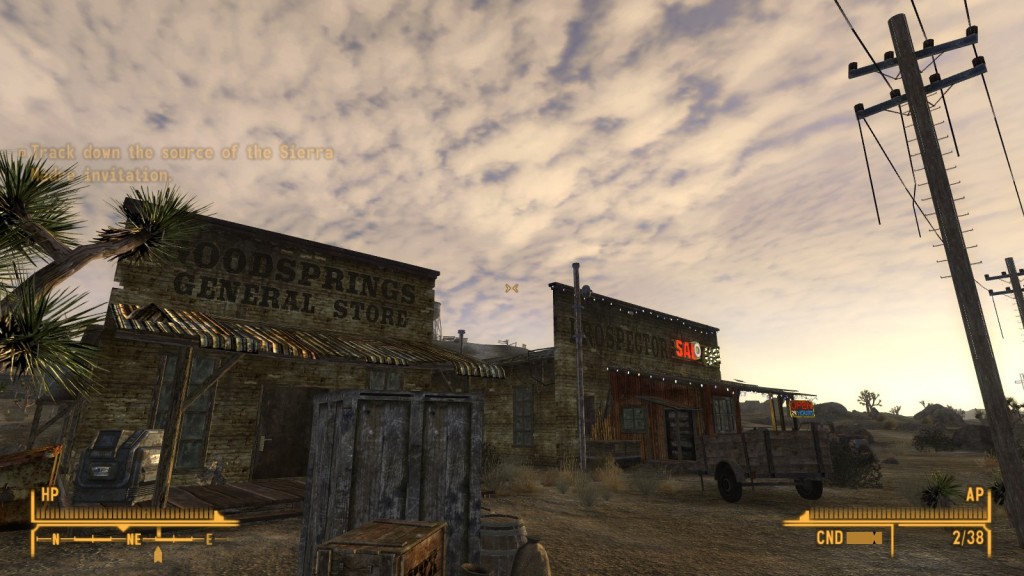
(With apologies to every writer, director, and star of the Wild West)
EXT. THE MOJAVE DESERT
The one-horse town of Goodsprings bakes, silent, in the Nevada heat. One after the other, we see several POWDER GANG BANDITS approach, cradling baseball bats and crude firearms. The Powder Gangers are in high spirits, looking forward to the plunder of the town.
POWDER GANGER #1: Pardner, I do reckon that there town be as easy as liquor flowing at the saloon.
POWDER GANGER #2: Yee-haw!
The Powder Gangers laugh, twirl their moustaches. Suddenly, they hear a yell.
An armoured figure – not one of the townspeople, but our hero, THE COURIER – charges out from between two houses. The Courier winds back his arm and for a moment, time seems to freeze. When it flows again, something red and fizzing has landed at the Powder Gangers’ feet.
POWDER GANGER #1: … Is that… dynamite?
FADE TO WHITE.
I’m ten hours into Fallout: New Vegas, the most unique-feeling entry in the venerable Fallout line of RPGs. Its predecessors (#1 and #3 in particular) revelled in their post-apocalyptic setting: their mohawked raiders could have come straight out of a Mad Max movie, and their civilisation was a precarious, hardscrabble thing – ersatz Bartertowns scattered around the wastes, each surviving as best as it could.
Choose your own adventure IN SPAAACE: The Fleet
The Fleet is a CYOA-esque piece of interactive fiction from indie outfit Choice of Games (I wrote about Choice of Broadsides, one of their earlier releases, last week). The Fleet trades in Broadsides’ sailing ships for space cruisers, and costs money ($3) whereas Broadsides was free, but in mechanical terms, the two are very similar. Both take about 30-60 minutes to play through, and both are about making choices that play to the main character’s strengths. (For instance, attempting fancy manoeuvres in Broadsides will lead to disaster if the player character has a low Sailing stat.)
Fleet’s greatest failing is that it lacks Broadsides’ charm – Fleet’s setting isn’t just space opera, it’s stock standard space opera. It will contain nothing new to anyone who’s read or watched much science fiction. Still, its plot – dealing with the trials and tribulations of a refugee fleet fighting to reclaim its homeworld – is serviceable, and I was thoroughly satisfied with the ending I achieved: I finished as a true statesman, someone who’d led his people – and the galaxy – to a better tomorrow. There are other endings out there, but I’m reluctant to replay the game to discover them – I don’t want to mar my first ending! Overall, a decent time-killer.
If you’d like more detailed looks at The Fleet, Pocket Tactics and Jay Is Games both have helpful reviews!
All aboard! Ticket to Ride: The Verdict
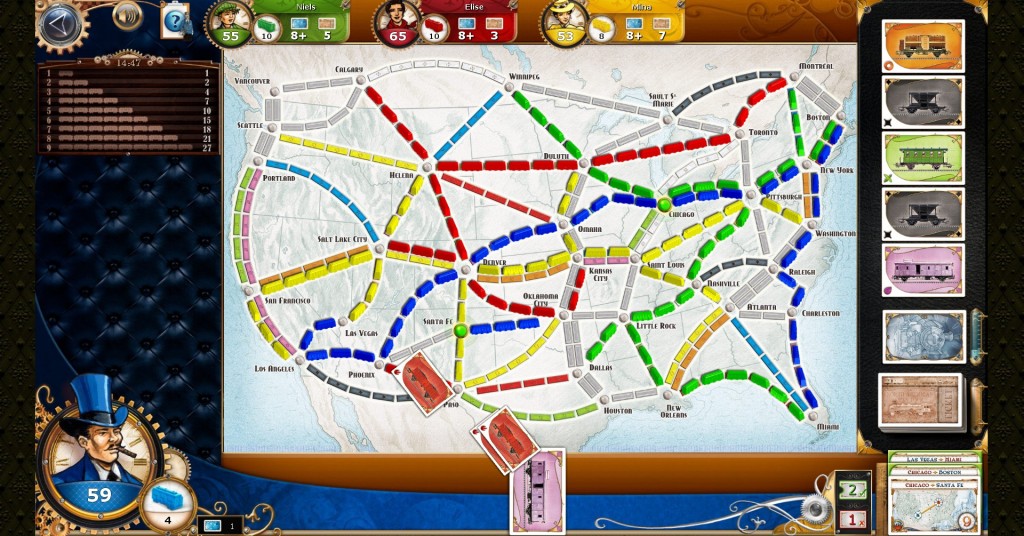
The railroad must get through. Chicago must connect to Santa Fe. But I’m almost out of locomotives, my rivals are muscling in, and can I get three cards of the same colour?
Welcome to Ticket to Ride, the PC adaptation of a highly regarded board game (which I have not yet played). In Ticket, players claim train routes by playing cards – six yellow cards to connect Seattle to Helena in the above screenshot, for instance, or five blue cards to connect Atlanta to Miami. Long routes are worth more than short routes, but are correspondingly harder to claim. Furthermore, each player begins with a certain number of “tickets” – routes (Chicago to Santa Fe, in my above example) that reward the player if they are completed, and impose a penalty if they are not. Again, long-haul tickets are worth more – both on the upside and on the downside! – than their short-haul counterparts. Lastly, each route can only be claimed by one player at a time (although the game does provide some duplicate routes). So for example, I couldn’t go Denver -> Santa Fe in the above screenshot, but neither could the other players go Denver -> Omaha, or Chicago -> Pittsburgh, or Pittsburgh -> New York.
Choose your own seafaring adventure: Choice of Broadsides
“Fire the starboard broadside!” shouts the Captain.
Cannons roar as H.M.S. Courageous attacks the enemy frigate. As one of the junior officers–really, more of an officer in training–you command three guns on Courageous’s main gun deck. The guns of the battery next to yours fire, leaping back against the heavy ropes that prevent them from smashing across the ship. Clouds of white smoke billow about you as you give your gun crew the commands to ready your battery’s cannons: “Swab! Powder! Wadding! Shot! Run out the guns!”
The Captain yells out, “Fire as the guns bear!” You give your gun crews orders to load and fire as quickly as they can, without waiting for the rest of the broadside.
They swab out the bore, push in a charge of powder, push wadding down on the powder, load the shot, push the gun out through the gunport, and fire the cannon, with you commanding each step of the process. “Swab, powder, wadding, shot, fire! Swab, powder, wadding, shot–”
The world turns upside down as the enemy’s broadside rips through the hull some ten feet away.
As the enemy cannonball tears through the side of the ship, giant splinters of wood fly through the air. One of the splinters, perhaps a yard long, rips through the stomach of Davies, a sailor under your command. A fragment of a cannon ball smashes Fisher’s arm, mangling it horribly. Your sailors seem stunned by the carnage, standing in shock while Davies and Fisher scream in agony.
What do you do?
A. Attend to the wounded personally–the safety of my sailors is my top concern.
B. Give some quick orders for them to be taken to the surgeon in the cockpit, then turn back to my duty in commanding the guns.
C. With a gut wound like that, Davies is done for, but Fisher can still be saved. I order some sailors to take Fisher to the cockpit but leave Davies on the deck to die. I need the extra sailors to use the guns effectively.
D. My duty to the ship outweighs my duty to two sailors. I ignore the wounded and concentrate on firing my guns as quickly and accurately as I can.
That is the opening of Choice of Broadsides, a free, short (30-60 minutes), and very good “choose your own adventure”-type game for Web, Android, and iOS. If you have ever read CS Forester, Patrick O’Brian, or one of their ilk, you will be right at home here: Broadsides chronicles your adventures as an officer in the Royal Navy of Great Britain Albion, during war against Napoleonic France Gaul. You start as a lowly midshipman, but you won’t stay that way! By the end of the game, I’d retired as an admiral, laden with honours – though not quite as much prize money as I’d hoped…
One of the greatest games of all time, Dominions 3, is now $30 at Desura & Gamersgate
First Aubrey & Maturin sailed into the digital world, and now one of my all-time favourite games, Illwinter’s strategy masterpiece Dominions 3, has finally made its way to digital download shops Desura (edit: and Gamersgate)! It’s also reasonably priced, at $30. Why is it one of my favourites?
1. It brings mythology/dark fantasy alive in a way that so few games – and almost no games outside RPGs – have managed. Elves? Orcs? Balrogs, even? Phooey. Dominions serves up titans plucked from Tartarus, queens of the air with clouds for bodies and lightning for fists, glamour-casting faery knights, and more. And in between scurry the poor human conscripts, so hopelessly outmatched as to underscore just how significant magic — and divinity — are to this world. (If you’d like to read more, a few years ago I wrote a guest piece on this very subject over at Flash of Steel.)
The Best Games of 2012
2013 has dawned, and it’s time to review the best of last year’s games (that I played). This year I’ve opted to break from the traditional “best RPG”, “best strategy”, etc format normally used in Game of the Year rankings. For one, it papers over the vast differences that exist within any genre: Dark Souls is not Skyrim is not Mass Effect. For another, there are sometimes multiple standout games within the same genre. So instead, I’ve opted to recognise games for their special achievements. Here are 2012’s exemplars:
Love, Hate, and Stories: The Visual Novels of Christine Love
To what heights – and depths – of emotion can we be moved by text in a game? This is the question posed by two of the best games I’ve played recently: Christine Love’s Digital: A Love Story and Analogue: A Hate Story.
Perhaps I shouldn’t call them games so much as I should call them interactive works of epistolary fiction, in which the player pieces together a story from documents and messages. The two titles contain very little in the way of abstract systems – apart from a couple of puzzles, there are no rules to be mastered here. This doesn’t mean the player is uninvolved! While both games rely on plenty of text, they also deploy that interactivity to good effect. They would not work in any other medium, something we’ll see with Digital.
Drox Operative: my impressions
Drox Operative is the latest title from Soldak Entertainment, an indie developer of action-RPGs (Depths of Peril, Din’s Curse) renowned for their dynamic worlds. Drox transports that concept from fantasy into space opera – its galaxy is filled with alien empires, who fight, intrigue, and negotiate amongst themselves. As one of the titular mercenaries, players accept quests from these empires, fight space monsters and rival empires, plant their patrons’ flags over unclaimed worlds – and try to make sure they’re on the winning side.
On paper, this is a wonderful concept, and it’s given me a couple of memorable moments. For example, at one point I wanted to explore a hazardous, monster-filled region of frontier space. To make my life easier, I took a quest to colonise a nearby planet, then stuck around to defend the new settlement. The result: now I had somewhere to repair, and the owner of the new colony was now both stronger and better disposed toward me. And there is a certain dark satisfaction in teaching recalcitrant alien empires why messing with a Drox operative is a bad idea! Unfortunately, these cool experiences have been the exception for me. As an overall package, Drox falls flat for me; while I can quibble with various “micro” aspects of the game’s execution (1), I think my ultimate problem lies with two key aspects of the game’s design:
Journey: The Verdict
How much can we care about a digital companion?
Whole games have been built around this question – most notably 2001 classic Ico, which cast players as a young boy who had to escape a witch’s castle together with a girl named Yorda. Together, the two made a team: Yorda was frail, but she was the only one who could open the castle’s magically sealed doors. And it worked: Ico is one of my all-time favourites. Subsequent games – such as the modern Princes of Persia – ran with this idea, but implemented it the same way: your companion was always computer-controlled, and there was a gameplay reason you needed to work with her (for good measure, it was always a her). Thatgamecompany’s Journey is the latest game to tackle this question… but this time, it puts its own spin on the formula.
In Journey, you play a cloaked traveller who has to cross the desert to reach a distant mountain. There is no dialogue, no narrative, and no exposition. Who is the traveller? The answer seems to be “a pilgrim”, but this isn’t stated outright anywhere – it’s something I deduced. Is the pilgrim a he, a she, or an it? I imagined my pilgrim as a she, but that was pure whimsy. Did she have family or friends before deciding to cross the desert? Who knows. Journey’s gameplay mechanics are equally minimalistic: mostly, the pilgrim walks towards her destination. She can use the magic in her scarf to jump or fly, and she can recharge her scarf by chirping musically when standing near bits of cloth scattered throughout the world – streamers, banners, magic carpets, and the like. This is pleasant enough – controlling the pilgrim is smooth and fluid, whether she’s on the sand or soaring through the air – but that’s about it as far as game mechanics go. There is no real challenge, except for looking/walking around, wondering where to go next. There are neither puzzles nor combat. There isn’t even a Game Over screen – it is impossible to die. The overall game is quite short, just a couple of hours. In this regard, Journey feels a lot like thatgamecompany’s previous title, Flower.
XCOM: Enemy Unknown – The Verdict
For one month, you followed me as I played through Firaxis’ XCOM: Enemy Unknown, the successor to one of the greatest games of all time. Now that I’ve finished, I can give my verdict: this is the true heir to the original, both in its strengths and its weaknesses.
At heart, both 1994’s X-COM and 2012’s XCOM are stories about heroism. That is something so many games claim to offer, but so few truly do. Heroism is not a power fantasy. Heroism is not about being the toughest guy alive (action games), or the sneakiest, or the cleverest general (Total War). Heroism is the courage to stand up against overwhelming odds, to endure loss and sacrifice on the road to victory. This is the experience that XCOM delivers in spades. Like its predecessor, XCOM follows a handful of outnumbered, outgunned, and oh-so-fragile men and women in their struggle against a technologically superior alien invasion. They are few enough, and diverse enough in their capabilities, to be distinct: I knew every name and face in my barracks. That makes it hurt all the more when they die – which they do often and permanently. For those odds, at least on “Classic” difficulty, really are overwhelming. On the world map, the aliens often launch three attacks at a time, while XCOM can only respond to one. Once in battle, XCOM operatives will usually die in two or three solid hits. But – and this is key – thanks to the context provided by the game’s strategic layer, that sacrifice never feels in vain. Slowly but surely, those brave underdogs will turn the tide of the war. With each battle, the survivors grow more skilled. With each pile of recovered alien loot, the survivors become better equipped. With each XCOM satellite and fighter plane (their construction funded by that loot), the world takes one step back from the brink. With each act of bravery by your soldiers, XCOM comes one step closer to victory.
Aviators of the smoky skies: Guns of Icarus Online
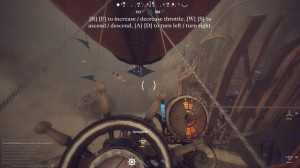
It seems all over for the crew of the airship Babbling Goldfish. On one side – the enemy, two airships bigger and heavier than ours. On the other – the ruins of a vast, ancient airship, still lodged vertically in the desert sand. Our hull and engines are being ripped to shreds, and the airship wreck blocks the most direct escape. Over voice chat, the consensus sounds in my ears: we’re going down. But manning the helm, I see one last chance. I steer us between towering pieces of wreckage – bare planks to our left, a piece of red-plated debris to our right. And the incoming barrage dies down. Did the wreck hide us from our pursuers? Or did they simply get bored and drift off? Whatever it is, we’re safe for now. Safe to make repairs, and safe to eventually rejoin the fight…
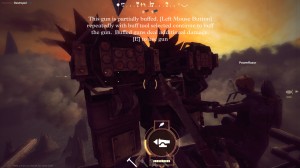
That is one of the stories I have accumulated in my last couple of weeks playing Guns of Icarus Online, a team-based airship combat title from indie studio Muse Games. (You might remember my very brief mention of the game last year, when it was just a trailer and a cool concept.) In Icarus, players take on the roles of airship crew – gunners, engineers, or pilots, with four crew members to one airship. (Note that the game is strictly PVP; while most unoccupied crew slots are filled by bots, each airship must be skippered by a human player.) Matches involve two teams (2-4 airships per side, depending on the map) either trying to score a set number of kills, or hold objective locations long enough to win. Each ship’s captain can choose between six available ship types, each of which can be further customised via choice of weapons – for instance, do I mount a flak cannon (long-ranged and best against the enemy hull), a carronade firing grapeshot (close-ranged balloon-popper), or a Manticore rocket launcher (long-ranged disabler) in my main gun slot? And depending on their class, crew members can choose which repair/buff items, ammo types, and piloting boosts to take into battle. Once in the game, the slow, deliberate combat feels closer to MechWarrior than to the typical FPS – ships take a while to reach their destination, and guns don’t fire that quickly. This changes once the ship takes damage – then it becomes a frantic game of ohnotheengineisred, and Someone fix the hull before we all die!
Let’s Play XCOM: Enemy Unknown! Part 7 (FINAL): Avenger
North America, 1 September 2015. The aliens’ forward base on Earth, the wee hours of the morning. Above the landing bay, a shape appears: XCOM’s Skyranger, followed moments later by a hover SHIV and five of XCOM’s finest operatives. The soldiers rappel down into the base, plasma rifles at the ready. Little do they expect what lies ahead: an anti-climax.
This is brilliant – video game characters drawn in traditional Japanese style
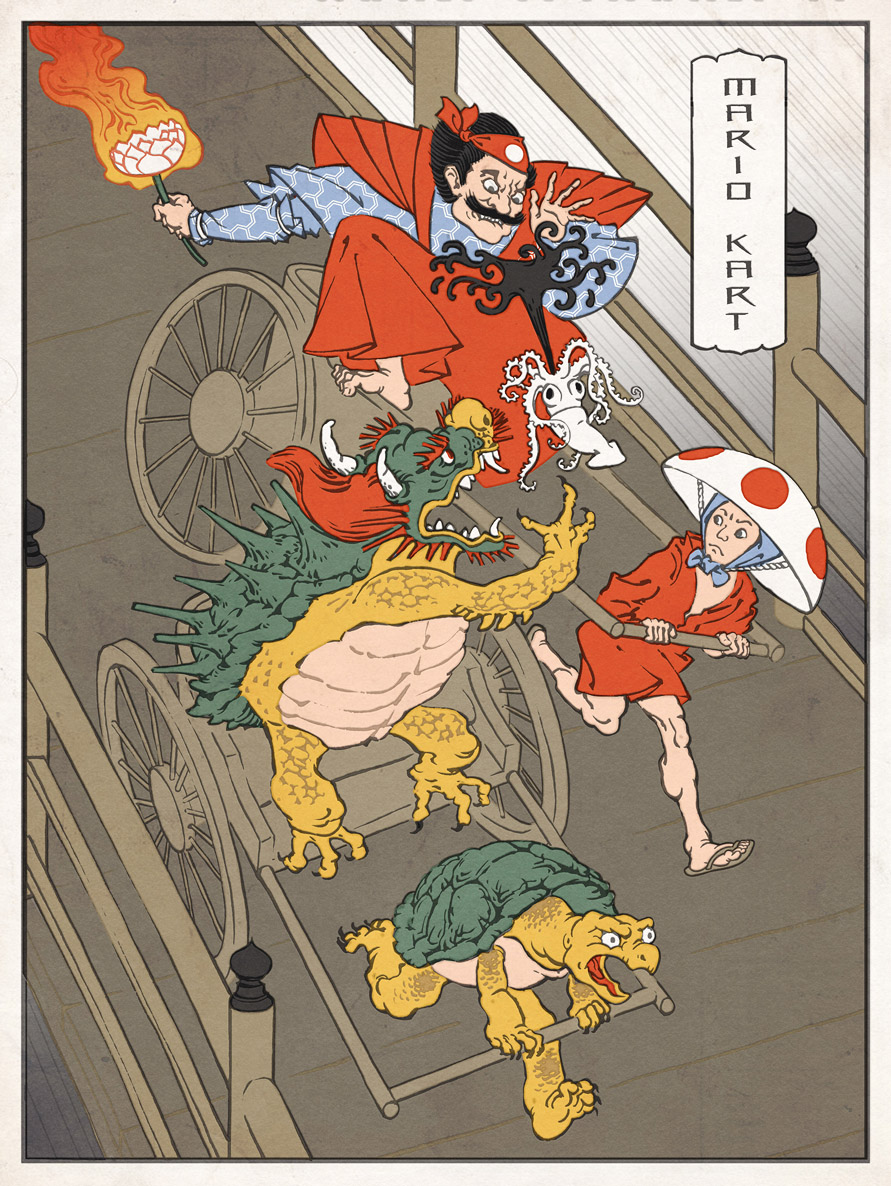
Ukiyo-e Heroes, an art series by Jed Henry, takes a simple concept (how would the heroes of classic video games look if they were drawn in traditional Japanese woodblock style?) and executes on it brilliantly. I love, for instance, the above riff on Mario Kart. Mario is clearly recognisable, but his garb, expression, body language, and of course, his vehicle have all been reimagined to fit the theme; the dimunitive Toad has become a rather scrawny rickshaw driver; and to cap things off, Mario and Bowser are pelting each other with period versions of, respectively, a red shell and Blooper the ink-filled squid.
You can view the other images in the series — Metroid, Sonic, Mega Man, Zelda, and more — at Jed’s site or at the series store. Unfortunately, at this point, it seems the only downloadable product at the store is a black-and-white colouring book ($10), while hardcopies are significantly more expensive (prints start at $40; and woodblock prints produced by Jed’s collaborator Dave Bull are $135). I’ve contacted Jed to ask if he plans to make a high-quality digital artbook available for purchase. Until then, enjoy the images on the site!
EDIT: Jed informs me via email that he “[thinks] a book will be coming in the next year or so”, so stay tuned!
Humble Bundle for Android #4: The Highlights (Waking Mars, Swords & Soldiers, Crayon Physics)
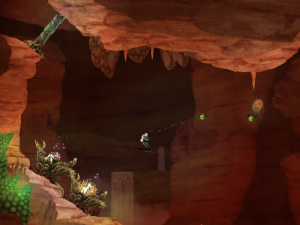
So I’ve had a few days to play around with the current Humble Bundle, Android #4– by way of introduction, this offers Android, PC, and Mac copies of five indie games (Splice, Eufloria, Waking Mars, Crayon Physics Deluxe, and Superbrothers: Sword & Sworcery EP) on a pay-what-you-want basis. Paying more than the average (currently $6.61) will add another six games: Machinarium, Avadon: The Black Fortress, Canabalt, Cogs, Swords & Soldiers HD, and Zen Bound 2.
Of these, I’ve dipped very briefly into Eufloria, Superbrothers, and Machinarium, but I’ve preferred to spend my time with Waking Mars, Crayon Physics (which I’ve owned on Steam for a while), and Swords & Soldiers (both on Android and on Steam). Brief thoughts below…
For Persona fans: Atlus cosplay!

Here’s something cool for the Persona fans — Atlus has announced the winners of its Halloween cosplay contest. There are some pretty striking photos at that link — I’ve excerpted one of the Grand Prize winner above, but there are plenty more. Enjoy!
Starbase Orion Android/PC port to be Kickstarted next year!
Good news, fellow Android gamers! Starbase Orion, Chimera Software LLC’s Master of Orion-style strategy game for iOS, may come to Android next year. I sent an email to developer Rocco Bowling, and this was his reply:
I will be holding a KickStarter campaign early next year to help raise funds to port SO to Android and PC. If it gets funded, it’ll get ported!
So keep an eye out for that campaign, folks!
Let’s Play XCOM: Enemy Unknown! Part 6: SHIVs, Stopgaps and Archangels
The battle of Melbourne, June 2015, dealt a bitter blow to XCOM. It left us down two countries and five soldiers (four of them amongst our finest veterans), and painfully exposed the inadequacies of XCOM equipment against the aliens’ latest toys. The laser weapons and carapace body armour that had served us so well, just a month or two ago, now look like a joke against Cyberdiscs. The new faces joining the squad are under-levelled marksmen of dubious skill.
But XCOM is a game about fighting back against the odds. This update is the story of how my survivors – a lopsided bunch, with too many snipers and too few heavies and support troopers – make do.
Let’s Play XCOM: Enemy Unknown! Part 5: Pride Goeth Before a Fall
As Part 4 ended, things were going smooth as butter. XCOM’s soldiers were winning battle after battle, and coming home almost invariably in one piece. The strategic layer was under control, thanks to XCOM’s ample satellites and newly ample cash.
As June 2015 dawns, it seems fair to ask: what could possibly go wrong?
Let’s Play XCOM: Enemy Unknown! Part 4: The Turning of the Tide
And we’re back!
After Part 3’s successful terror mission, the rest of April passes without incident. Dr Vahlen and her scientists finish research on beam weapons, which unlocks laser pistols and laser assault rifles for use by my squad!
Unfortunately, I’m too broke to build more than one of each. Not only do they hoover up cash, they also require precious alien alloys – and my stock of alloys is running dangerously low. Farnsworth gets the laser rifle; LeSquide, our sniper, gets the laser pistol (since he can’t move and fire his sniper rifle in the same turn, he’s the one most in need of a decent sidearm).
At the end of the month, the Council gives us our scorecard and funding cheque:
As feared, the XCOM Project has lost its first two countries: Japan and Mexico have raised the white flag to the aliens. Three more, Argentina, India and China, are teetering. But all is not lost – I have no fewer than three satellites in the pipeline, plus the cash to build more (and their supporting infrastructure). This coming month, May, will be do-or-die. If XCOM can make it through the month in one piece, by its end I should have enough satellites to halt the tide of global panic. More than that, I’ll have so many satellites, and so much funding, that I’ll never have to worry about scrimping and saving again. If, if, if.
Let’s see how I go.
Let’s Play XCOM: Enemy Unknown! Part 3: Terror and Triumph
Welcome to the third part of my Let’s Play (Classic difficulty, Ironman mode) for XCOM: Enemy Unknown!
When we previously left off, I had two worries. One, whether I could obtain better arms and armour before the game ramped up in difficulty. Two, a rising tide of global panic. And soon, the game does its best to exacerbate (2) by throwing a devil’s choice at me:
Let’s Play XCOM: Enemy Unknown! Part 2: Winning battles, whither the war?
Welcome back to my Let’s Play (Classic difficulty, Ironman mode) of XCOM: Enemy Unknown! We finished our last instalment on March 20 (game time), with a successful end to XCOM’s third battle. Following that battle, XCOM earned a new, experienced Heavy named Talorc, and I began construction of the Officer Training School.
But before I can train any officers, not one day after the previous mission, it’s time to sortie again:
Let’s Play XCOM: Enemy Unknown! Part 1: Baby Steps
March, 2015. We are not alone in the universe. Humanity is under attack from an alien army equipped with technology beyond anything we have seen. The armed forces of the Earth are powerless. All save one – the mysterious international organisation known as XCOM, sponsored by a Council of sixteen nations. It’s up to XCOM’s soldiers, outnumbered, outgunned, but brave and (one hopes) well led, to stop the aliens in the cities and in the fields. It’s up to XCOM’s scientists to unravel the alien technology the soldiers bring home, and up to XCOM’s engineers to adapt it into something the troops can use. And it’s up to me, the player, to give them all direction. Will I succeed, or will humanity be destined to end up as just another course on the alien buffet menu?
Let’s find out.
X-COM: That which kills us makes us very dead
With the new XCOM game around the corner, it’s time to reflect on the fallen. The First and Second Alien Wars had horrific death tolls. Tens, hundreds, thousands of little pixel-dudes rotated on the spot to face the player, screamed, and fell down to never rise again. Always those brave men and women turned to face the player. We looked them in the tiny pixel-eye as they expired. It was the least we owed them. Heroes, every one.
What were the main causes of death in these brutal, bloody conflicts? Read on…
The First Alien War is UFO: Enemy Unknown, aka X-COM: UFO Defence for the non-Europeans. The Second War is known by the codename Terror from the Deep. The Third Alien War, dubbed Apocalypse, will not feature here as I sat that one out.
Highlights from the EB Games Expo Sydney 2012: The Last of Us, Tomb Raider, Wii U, Australian indies and more!
For the last three days the Sydney Showground has played host to the EB Games Expo, and that was where I spent yesterday. There I met some folks from the industry, both publishers and indie developers; watched trailers and gameplay videos; observed live play; and last but not least, tried out a few titles for myself! Here are the highlights of what I saw (grouped by publisher):
Banner Saga’s single-player sounds promising
Banner Saga, a Norse-themed tactical RPG trilogy from indie studio Stoic Games, was one of the early titles to ride to prominence on Kickstarter this year. Now Nathan Grayson of Rock, Paper, Shotgun has posted a monster three-part interview/preview, and it’s fascinating stuff — especially the third part, in which the developers explain how the single-player campaign will work (in summary, “it’s a bit like of King of Dragon Pass meets Oregon Trail. It’s King of Dragon Pass on the road.”) While not quite a full branching campaign a la The Witcher 2, the player’s choices will matter, both from a gameplay and a story perspective. Characters will join or leave the party based on their satisfaction with the player; the player will have to juggle the party’s endurance and morale against the need to stay ahead of an all-consuming wall of darkness (this actually put me in mind of FTL), and there will be multiple endings. If that sounds interesting, it’s well worth heading over to check out the full article.
Meanwhile, we’ll get our chance to evaluate the core gameplay next month when a spin-off F2P multiplayer game based around the battle system, Banner Saga: Factions, is due out. This is one project that I’ll keep an eye on.
Sleeping Dogs – The Verdict
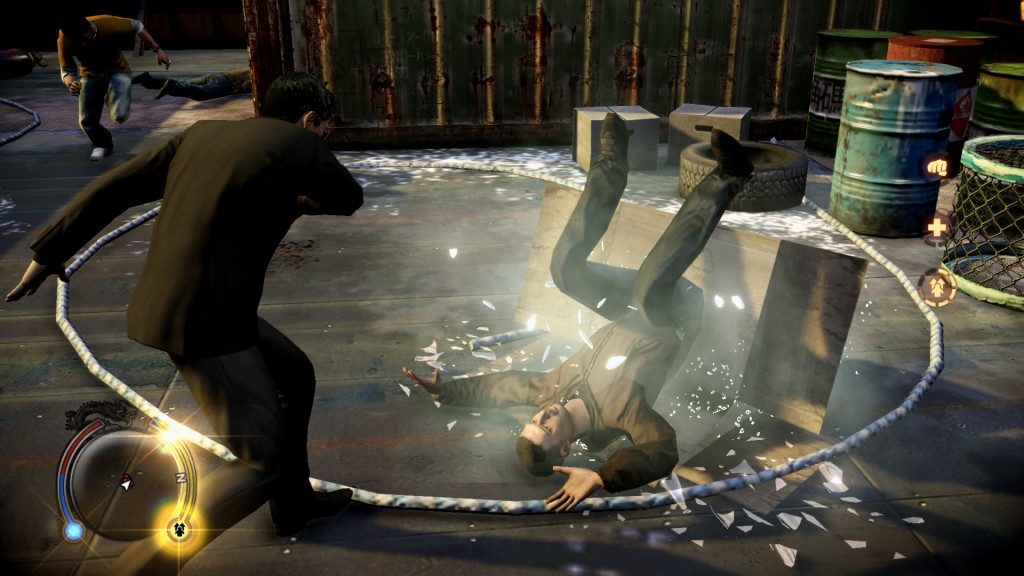
I must be one of the few gamers out there not to have played Grand Theft Auto, or any of the other modern-day, open-world, crime-themed games that it spawned. None had premises that appealed to me – until now. Enter Sleeping Dogs, United Front Games’ open-world extravaganza, which casts the player as undercover cop Wei Shen, tasked to infiltrate the most powerful crime syndicate in Hong Kong. This premise has been mined many times before for its dramatic potential, with the most obvious parallel being 2002 Hong Kong thriller Infernal Affairs. However, the key to Sleeping Dogs is that it’s not a homage to thrillers – it’s a homage to action flicks.
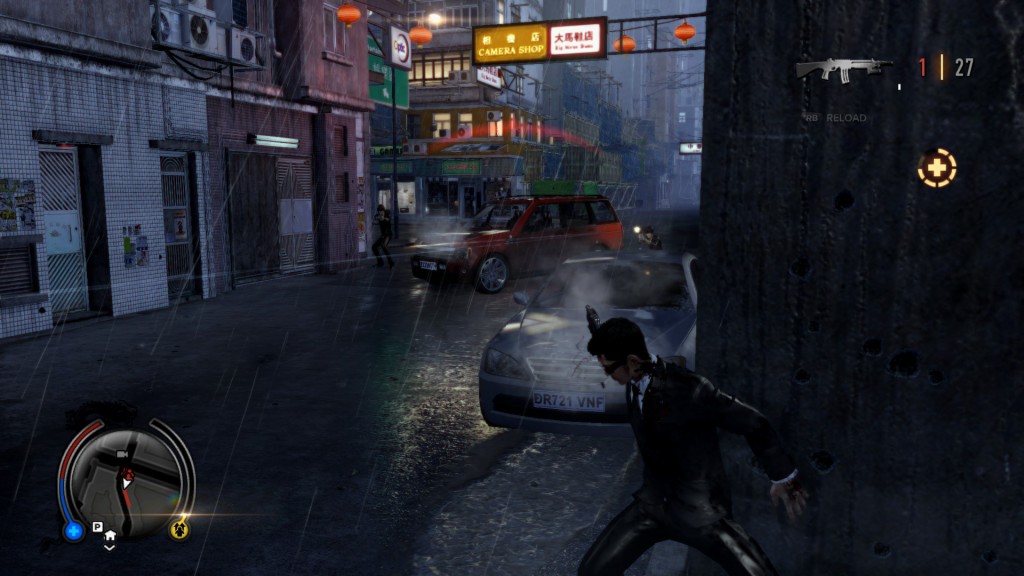
Specifically, Sleeping Dogs’ gameplay revolves around two activities: chasing rival mobsters, and pulverising them once you catch up. You chase them on foot (think the opening parkour sequence of Casino Royale) and in cars; you fight with fists, feet, and occasionally, firearms. The typical mission will involve pretty much every variation on these themes: Wei might drive to a target’s lair, disembark to beat up a first wave of guards, grab a gun to deal with a second wave of guards, jump into a car to pursue his escaping quarry, and finally jump from car to car in mid-chase to reach his foe. In between missions, there are other diversions available – special mention goes to a hilarious karaoke minigame (watch Wei during guitar solos, but make sure you don’t have anything in your mouth) – but speed and violence generally dominate the side quests, too.
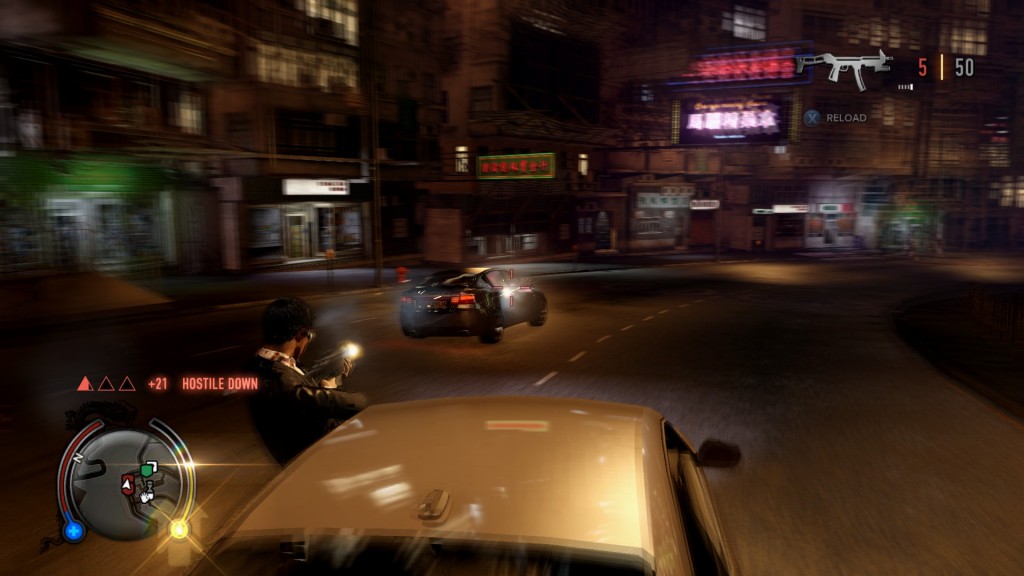
This is not a flaw.
What Sleeping Dogs does best is recreate the excitement – and yes, over-the-top destruction – of good action movies. There are deeper dedicated brawlers out there – tapping or holding one button will run Wei through predefined combo moves; tapping a second button will counter enemy attacks; a third will allow Wei to grapple enemies and, often, finish them off with a spectacular use of the environment, such as throwing them into the water, slamming them into fuse boxes, or even impaling them on swordfish. There are deeper shooters out there: Wei’s options largely comprise hiding behind cover, popping up to shoot, or vaulting over an obstacle in order to enter bullet time. And while I’m no expert on racing games, I would be very surprised if there weren’t games with deeper driving models. But while each component is straightforward, the game (and the individual missions) string them together into an overall experience greater than the sum of its parts.
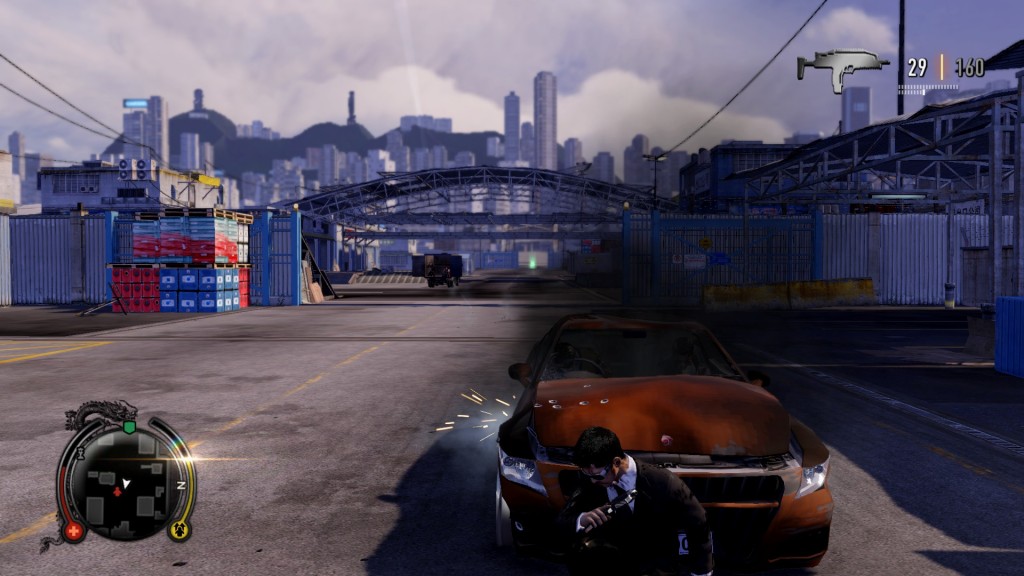
The same holds true for the game’s story. Some sequences are laugh-out-loud funny, though they tend to be merely the comic relief between far darker events. On a deeper level, while the game is a long way from Shakespeare, it understands the importance of theme and character arc. Without them, I doubt I would have seen Sleeping Dogs through to the end – after 28 hours, I was getting a little bored of beating up gangsters and detonating their cars. With them, Wei’s adventures became a coherent, satisfying narrative filled with characters I cared about – characters who acquired depth through their different responses to one of the game’s central ideas, the lure of crime. I wanted to see how their stories would end, and that desire propelled me through an increasingly explosive (in every sense of the word) plot all the way to the credits. Far more ambitious games have done far worse.
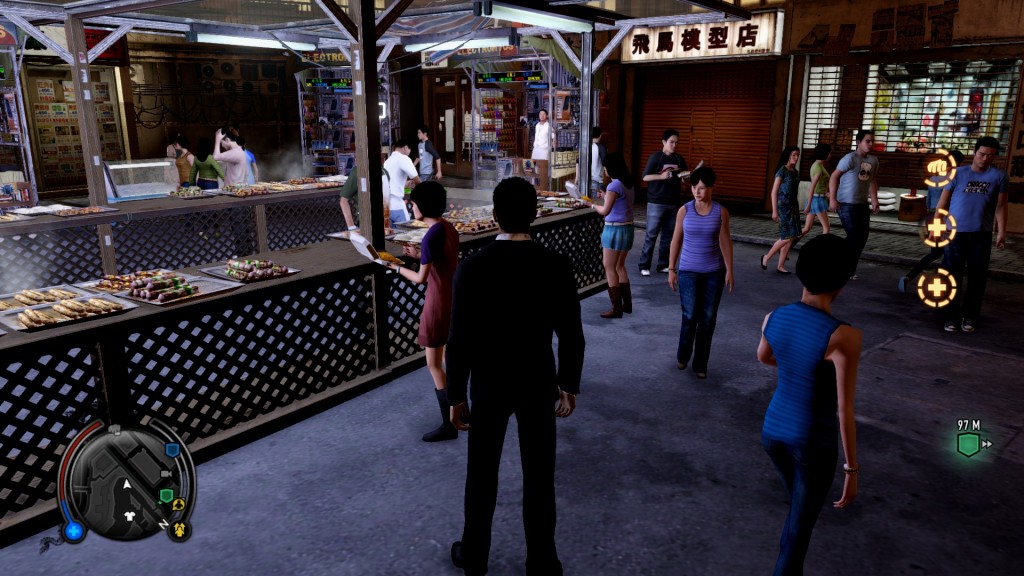
Lastly, I should give a shout-out to the game’s soundtrack, which did so much to convey a sense of place. There are quite a few songs available, but my favourites by far were the (often instrumental) Chinese tracks. Motoring around the game’s version of Hong Kong, with the rain pouring and the car radio pumping this into my ears, wasn’t just atmospheric and relaxing. In its own small way, it was an experience I could not have gotten from another game.
At the end of the day, I couldn’t have asked for a better introduction than this to the modern-day open-world genre. Sometimes hilarious, sometimes horrifying, often exciting, and always entertaining, Sleeping Dogs is a very good game, well worth my money. I look forward to seeing what UFG does next.
We hope you enjoyed this post! To quickly find this post, and our other reviews, click the “reviews” tab at the top of this page.
Resources
An interesting take on the game’s story (some spoilers) (WSJ)
Buy Sleeping Dogs from Amazon (US)
The basis of my review
Length of time spent with the game: 28 hours.
What I played: The entire story, and many of the game’s side quests.
What I didn’t play: The remaining side quests.
